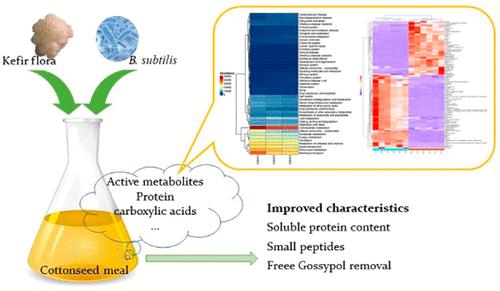当前位置:
X-MOL 学术
›
ACS Food Sci. Technol.
›
论文详情
Our official English website, www.x-mol.net, welcomes your feedback! (Note: you will need to create a separate account there.)
Cofermentation of Cottonseed Meal by the Synergistic Action of Microbial Flora with Protease and Its Metabolic Kinetic
ACS Food Science & Technology Pub Date : 2024-02-21 , DOI: 10.1021/acsfoodscitech.3c00662 Shuang Ni 1 , Dawei Zhao 2, 3 , Keyang Li 1 , Yue Wu 1 , Shaohua Yang 1 , Xiaoyan Chen 3 , Zhiying Cui 3 , Xianghua Yan 2 , Guoqing Liu 1
ACS Food Science & Technology Pub Date : 2024-02-21 , DOI: 10.1021/acsfoodscitech.3c00662 Shuang Ni 1 , Dawei Zhao 2, 3 , Keyang Li 1 , Yue Wu 1 , Shaohua Yang 1 , Xiaoyan Chen 3 , Zhiying Cui 3 , Xianghua Yan 2 , Guoqing Liu 1
Affiliation

|
Cottonseed meal (CSM), a high-protein-content waste from the cottonseed oil industry, shows potential application as an animal feeding resource, which is hindered by its endogenous antinutritional factor (free gossypol). Microbial fermentation of CSM by the synergistic action of Bacillus subtilis, kefir flora, and alkaline protease was applied for CSM property improvement, including free gossypol removal, protein solubility, and bioactive compounds content in the present study. A maximal extent of 78% for free gossypol removal and an increase of total soluble protein content to 58.11% were achieved under the optimal fermentation conditions obtained via BBD-RSM design. The volatile base nitrogen reduction and bioactive peptides synthesis were also observed in the fermented CSM. The analysis results of metabolomics and metagenomics by integrated metabolomics and metagenomics techniques indicated the microorganism consortium secreted multiple enzymes for proteolysis and resulted in the variation of metabolite composition which was involved in the metabolisms of carboxylic acids, benzene, glycerophospholipid, allyl alcohol lipids, steroids, flavonoids, phenols, and their derivatives. The fermented CSM also showed improved angiotensin I-converting enzyme inhibition (86.72%) and antioxidant activities (87.51%) which might be due to the bioactive compounds generated by the cooperation of B. subtilis and kefir flora.
中文翻译:

微生物菌群与蛋白酶协同发酵棉籽粕及其代谢动力学
棉籽粕 (CSM) 是一种来自棉籽油工业的高蛋白含量废物,显示出作为动物饲料资源的潜在应用,但其内源性抗营养因子(游离棉酚)阻碍了这一应用。在本研究中,通过枯草芽孢杆菌、开菲尔菌群和碱性蛋白酶的协同作用对CSM进行微生物发酵,以改善CSM的特性,包括游离棉酚的去除、蛋白质溶解度和生物活性化合物的含量。通过BBD-RSM设计得出的最佳发酵条件下,游离棉酚去除率最大达到78%,可溶性总蛋白含量提高到58.11%。在发酵的 CSM 中还观察到挥发性碱氮的减少和生物活性肽的合成。综合代谢组学和宏基因组学技术的代谢组学和宏基因组学分析结果表明,微生物群落分泌多种蛋白水解酶,导致代谢物组成发生变化,涉及羧酸、苯、甘油磷脂、烯丙醇脂质、类固醇、类黄酮、酚类及其衍生物。发酵的CSM还表现出改善的血管紧张素I转换酶抑制(86.72%)和抗氧化活性(87.51%),这可能是由于枯草芽孢杆菌和开菲尔菌群合作产生的生物活性化合物。
更新日期:2024-02-21
中文翻译:

微生物菌群与蛋白酶协同发酵棉籽粕及其代谢动力学
棉籽粕 (CSM) 是一种来自棉籽油工业的高蛋白含量废物,显示出作为动物饲料资源的潜在应用,但其内源性抗营养因子(游离棉酚)阻碍了这一应用。在本研究中,通过枯草芽孢杆菌、开菲尔菌群和碱性蛋白酶的协同作用对CSM进行微生物发酵,以改善CSM的特性,包括游离棉酚的去除、蛋白质溶解度和生物活性化合物的含量。通过BBD-RSM设计得出的最佳发酵条件下,游离棉酚去除率最大达到78%,可溶性总蛋白含量提高到58.11%。在发酵的 CSM 中还观察到挥发性碱氮的减少和生物活性肽的合成。综合代谢组学和宏基因组学技术的代谢组学和宏基因组学分析结果表明,微生物群落分泌多种蛋白水解酶,导致代谢物组成发生变化,涉及羧酸、苯、甘油磷脂、烯丙醇脂质、类固醇、类黄酮、酚类及其衍生物。发酵的CSM还表现出改善的血管紧张素I转换酶抑制(86.72%)和抗氧化活性(87.51%),这可能是由于枯草芽孢杆菌和开菲尔菌群合作产生的生物活性化合物。



























 京公网安备 11010802027423号
京公网安备 11010802027423号